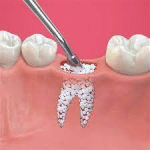Periodontal surgery may be recommended if it is likely to improve the long-term stability of the gum condition.
Purpose
- To gain proper access to the roots of your teeth so that they can be cleaned effectively. Studies have shown that, where there are deep pockets, it is almost impossible to properly clean without surgery
- Removal of the plaque and tartar buildup
- Correction of the gingival and bony deformities
- Reduction or elimination of the residual pockets to allow proper access for an efficient daily home care regimen.
- To regenerate the supporting bone if possible.
Possible complications
- Even with proper care, gum surgery carries some risk. Varying amounts of discomfort, swelling, and bruising, can be expected. The use of ice packs and anti-inflammatory medication can help control these post-operative events. Most patients require very little pain medication.
- Although rare, infections of the surgical sites do occur. Antiseptic rinses and antibiotics may be used to prevent or treat infections. A meticulous oral hygiene routine is important before and after surgery to keep your mouth as clean as possible to reduce the risk of infection.
- Some bleeding is expected after surgery but is usually slight and stops in a few hours.
- Your teeth may feel and appear longer as a result of removing the infected tissue and pockets. You may also notice more space between your teeth in which food may get trapped.
- The affected teeth may appear looser until complete healing is achieved.
- Surgery done in the lower jaw is often near the main sensory nerves to the chin, lower lip, tongue and gums. Sometimes, in spite of all precautions, these nerves can be bruised or injured. The result may be partial or complete numbness (or less commonly, burning, tingling or pain) of the lower lip, chin, tongue, and gum tissue on that side. Surgery done in the upper jaw can affect the sensory nerves in the roof of your mouth. Altered sensations usually do not last more than a few weeks, improving as the nerve repairs itself. In some cases, the altered sensation may last months or years and may be permanent. The occurrence and duration of this complication is unpredictable. Altered sensations are rare and do not affect appearance.
- Increased root sensitivity of treated teeth can occur. This is usually transient and improves over time. If needed, the application of a topical agent can ease these symptoms.
- There may be damage of treated teeth and adjacent teeth or existing restorations. All precautions are taken to avoid this from occurring.
- Medicines such as the birth control pill may become less effective if taken along with other medications you may be given. Be sure to provide your dentist, hygienist, and Dr. Glick with a complete list of your medications – including non-prescription drugs, herbal supplements, and vitamins.
What to expect
- Gum surgery is performed in keeping with general surgical principles: with sterile instruments, good light, and a dry operative field.
- Gum surgery typically is done under local anesthesia and you should be completely pain-free during the procedure. If you are very anxious or nervous, additional medications can be used to make you more comfortable. Be sure to discuss these concerns with Dr. Glick during your consultation.
- Gum surgery is a very delicate and precise procedure and will take 30 to 90 minutes per site.
- Specific post-operative instructions will be given to you following surgery.
- Post-operative visits will be arranged in order for Dr. Glick to monitor healing and progress.
Types of periodontal surgery
Resective treatment
This surgical treatment is performed to reduce the thickness of the gingiva (gums) in order to reduce pocket depth.


Regenerative treatment
This surgical treatment consists of regenerating (rebuilding) the bony support and gum attachment to the tooth root. Although this technique is preferable to the resective approach, it requires several prerequisites that often are not present. In addition, its outcome is less predictable. Due to limitations in current materials and variations in local and host factors, complete regeneration is seldom achieved.



Alveolar ridge preservation
A tooth is held in place in the jaw by the bone that surrounds its root. After a tooth is lost, the space its root occupied in the bone is normally filled with new bone and the gum will cover that space. However, this filling process is often not adequate and this leads to reduced bone and gum levels in the area where the tooth was lost.
This local bone/gum shrinkage, can cause esthetic and functional problems. It can make it difficult or even impossible to place a dental implant in the future, as there may not be enough bone left to hold it in a proper position. Also, if the bone/gum shrinkage is in the smile area, this could result in an unaesthetic appearance that would be difficult to hide and correct. As such, if the extracted tooth is in an esthetic zone or if the tooth will be replaced by an implant, it is advisable to do the ridge preservation procedure.
During this procedure, mineral particles (artificial or natural bone) are placed in the socket right after the extraction. These particles are often covered with a small membrane to keep everything in place. This procedure allows for the reconstruction of the local bone that may have been extensively destroyed by an infection around the extracted tooth.

Free gingival graft
A gum graft (also called free gingival graft) increases the attached tissue and stops the progression of recessions. It is placed at the base of the tooth and does not cover the already-exposed root surface.
Root coverage without using a gum graft
Sometimes the exposed root of a tooth can be covered without using a gum graft. If there is sufficient solid gum tissue next to the exposed root, the gum can simply be moved over the root to cover it. In such instances, a product that promotes the binding of the gum to the tooth can be used.
Your periodontist will let you know if this technique is appropriate for you.
Connective tissue (root coverage) graft
This type of graft is placed over the root to cover the already-exposed root surface. It increases the attached tissue and stops the progression of gingival recession. The success rate of this procedure is variable depending on the shape and extent of the recession. Healing will be compromised with smokers.
When a gum graft is suggested to cover an exposed root, you or your periodontist may choose to use a material other than the gum available in your mouth (usually from the palate). One option is to use dermis (a layer of the skin) that is harvested from human donors (allogenic). The graft may also come from the collagen extracted from pigs (xenogenic). These materials come from recognized tissue banks that sterilize and test these tissues for safety. However, these graft materials are not suitable for all situations.


A graft is a thin piece of gum tissue usually taken from the roof of the mouth. The graft is usually placed over the recession (outlined), to strengthen the attached tissue, improve the esthetics and reduce root sensitivity.

This is a picture showing some recession and thin attached tissue.

This is the same tooth after a graft successfully covered the root surface and increased the attached tissue.
It is not always possible to cover all the root surface.
Sinus lift
On each side of the top jaw, above the roots of the back teeth, there is a small air-filled cavity, called the sinus. The amount of bone between the back teeth and the sinus is often limited, especially after a tooth has been lost. A “sinus lift” procedure will augment the bone under the sinus area, to create sufficient bone height and width to properly place and support an implant. Two sinus lift approaches are possible.
The first is the lateral approach, where the periodontist makes a small opening in the gums near the sinus and inserts mineral particles (synthetic or natural bone) under the lining of the sinus. The opening is then carefully closed with a membrane under the gums. Depending on how much bone is available at the time of the sinus lift, implants may be placed immediately, or after waiting a few months for the new bone to mature. Before placing an implant, a small opening that has the implant shape and size has to be drilled in the bone.
In the second method, the crestal approach, the mineral particles are inserted under the sinus lining, through this opening. This procedure is usually performed just before the implant is inserted.

Side effects of surgery
Although the benefits of surgical treatment outweigh the side effects, these may include :
- Gingival recession (the appearance of longer teeth)
- Spaces between teeth secondary to the bone loss
- Aesthetic change and increased cold sensitivity, but this is usually for a short time only
